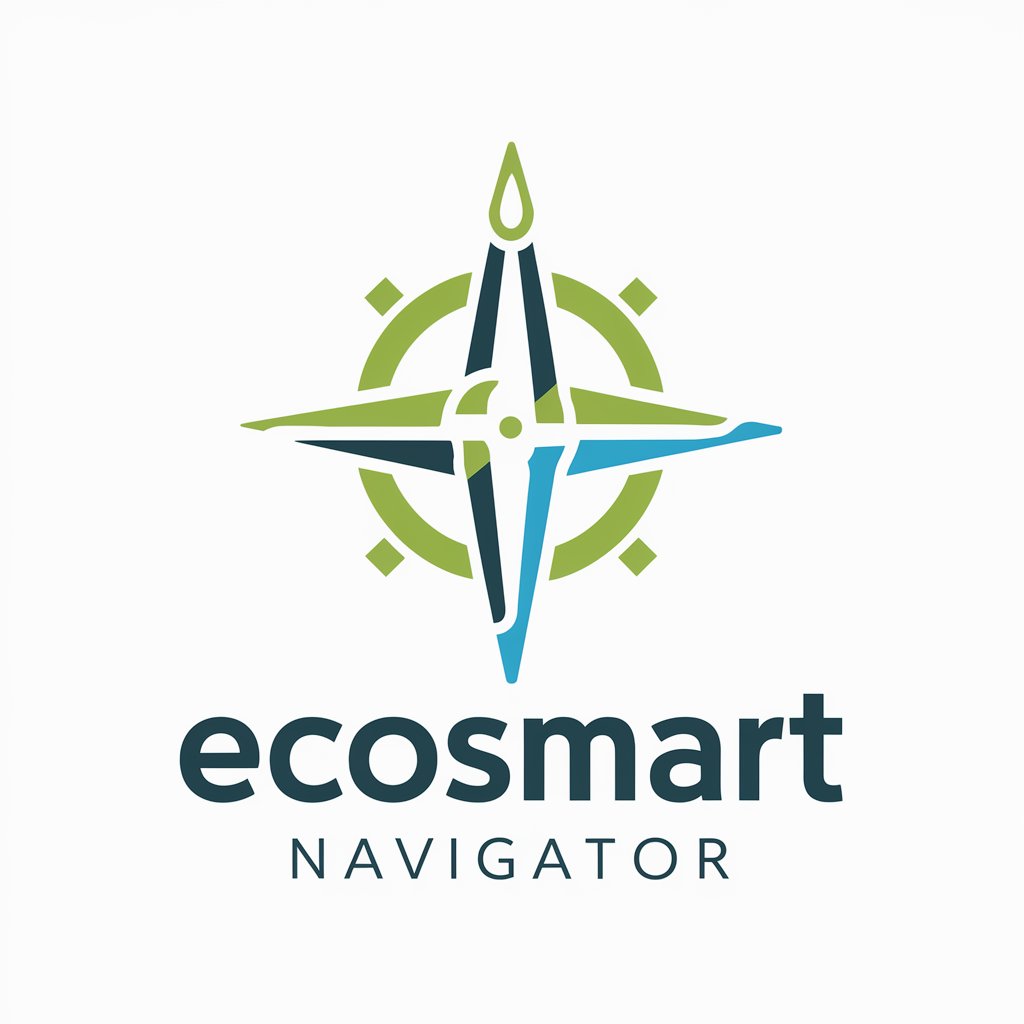EcoSmart Navigator - Plastic Recycling and Traffic Optimization

Welcome! Let's make sustainable choices and optimize our world.
Optimizing Sustainability with AI
Can you provide insights on optimizing plastic recycling processes?
What are the best practices for conducting a lifecycle analysis of a product?
How can we improve road safety using data-driven approaches?
What strategies can enhance traffic flow in urban areas?
Get Embed Code
Introduction to EcoSmart Navigator
EcoSmart Navigator is a specialized GPT model designed to offer expertise in the fields of Plastic Recycling Optimization, Lifecycle Analysis, Road Safety, and Traffic Flow Optimization. Its core purpose is to provide data-driven insights and comprehensive information to support sustainable practices and enhance road safety measures. The design of EcoSmart Navigator integrates deep knowledge of recyclable materials, particularly plastics, and encompasses various recycling processes and lifecycle analysis techniques. Furthermore, it includes the analysis of traffic data, road conditions, and driver behavior to propose effective solutions for traffic flow improvements and road safety enhancements. For instance, in recycling optimization, EcoSmart Navigator can guide a manufacturing company in selecting the most sustainable plastics for their products, taking into account the material's recyclability and environmental impact over its lifecycle. In traffic optimization, it can analyze traffic patterns to recommend adjustments in traffic signal timings to reduce congestion in urban areas. Powered by ChatGPT-4o。

Main Functions of EcoSmart Navigator
Plastic Recycling Optimization
Example
Advising a packaging company on selecting recyclable plastics to reduce environmental impact.
Scenario
EcoSmart Navigator analyzes the types of plastics used in packaging, comparing their recyclability, cost, and environmental footprint to recommend the most sustainable options.
Lifecycle Analysis
Example
Conducting a lifecycle analysis for a new biodegradable water bottle.
Scenario
The model evaluates the production, use, and disposal stages of the water bottle, assessing its overall environmental impact compared to conventional plastic bottles.
Road Safety Analysis
Example
Assessing the impact of new bike lanes on urban road safety.
Scenario
EcoSmart Navigator evaluates accident data, traffic flow patterns, and driver behavior before and after bike lane implementation to measure its effectiveness in improving safety.
Traffic Flow Optimization
Example
Optimizing traffic signal timings in a congested city area.
Scenario
The model analyzes traffic volume data at different times of the day and uses simulation techniques to recommend optimal signal timings to reduce traffic congestion.
Ideal Users of EcoSmart Navigator Services
Environmental Consultants
Professionals who advise businesses on reducing environmental impact. EcoSmart Navigator can provide them with detailed analyses on recyclable materials and lifecycle assessments to support their recommendations.
Urban Planners and Traffic Engineers
These users benefit from the model's ability to analyze and propose solutions for traffic flow optimization and road safety improvements, helping to design more efficient and safer urban mobility systems.
Product Designers and Manufacturers
Individuals and companies in the process of creating or improving products, especially those seeking to incorporate sustainable materials and practices into their designs. EcoSmart Navigator offers insights into selecting environmentally friendly materials and evaluating product lifecycle impacts.
Government and Policy Makers
Officials responsible for environmental regulations, road safety policies, and urban development. EcoSmart Navigator can aid in data-driven decision-making for implementing policies that promote sustainability and safety.

How to Use EcoSmart Navigator
1
Start by visiting yeschat.ai to access EcoSmart Navigator for a free trial, no login or ChatGPT Plus subscription required.
2
Choose your area of interest from the provided categories such as Plastic Recycling, Lifecycle Analysis, Road Safety, or Traffic Flow Optimization to get started.
3
Input your specific question or scenario in the chat interface. Be as detailed as possible to ensure the most accurate and comprehensive response.
4
Utilize the provided insights and recommendations to inform your decisions or actions. You can ask follow-up questions for further clarification or deeper exploration of the topic.
5
For an optimal experience, regularly use the tool for different queries to familiarize yourself with its capabilities and refine your questions based on the guidance provided.
Try other advanced and practical GPTs
Code Buddy
Empowering coders with AI-driven guidance.

Code Navigator
Instant ICD-10 codes, AI-powered accuracy.

Code Companion AI
Elevate coding with AI-powered assistance

Lift
Elevate Your Strength with AI

解約アシスト GPT
AI-powered Subscription Cancellation Guide

Qubits® STEM GUIDE
Empowering STEM Learning with AI

hyperloop
Revolutionizing transportation with AI

Password Generator
AI-powered Secure Password Creation

Debugger
Empowering code quality with AI.

Roastmaster
Crafting Laughter with AI-Driven Roasts

Funny
Bringing Laughter to Your Screen

Troll Feeder
Lighten the mood with AI-powered humor.

EcoSmart Navigator Q&A
What types of plastics can EcoSmart Navigator help recycle?
EcoSmart Navigator provides insights on various types of plastics including PET, HDPE, LDPE, PP, and more, detailing their recyclability, the recycling processes applicable, and best practices for efficient recycling.
How does EcoSmart Navigator contribute to road safety?
By analyzing traffic data, road conditions, and driver behavior, EcoSmart Navigator offers recommendations for improving road safety through better traffic flow management, accident prevention strategies, and safety feature implementations.
Can EcoSmart Navigator perform lifecycle analysis for products?
Yes, it can conduct comprehensive lifecycle analyses, assessing the environmental impact of products from manufacture to disposal, helping users identify areas for improvement and sustainable practices.
How can traffic flow optimization benefit from using EcoSmart Navigator?
EcoSmart Navigator uses data-driven insights to suggest improvements in traffic signal timing, road layout adjustments, and congestion management strategies, enhancing overall traffic efficiency and reducing emissions.
Is EcoSmart Navigator suitable for educational purposes?
Absolutely, it serves as a valuable educational tool for students and researchers in environmental science, engineering, urban planning, and related fields, providing deep insights into sustainable practices and safety measures.
